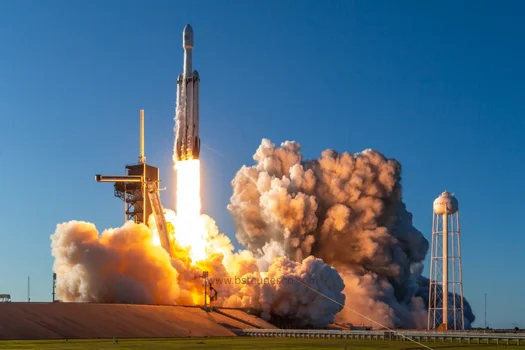Humanity’s incredible progress in aerospace engineering has made it possible to launch satellites and spacecraft into space with increasing precision. But how exactly do rockets work? Why do they require so much fuel? And how do satellites stay in orbit around Earth? In this article, we’ll explore the science behind rocket launches, propulsion systems, and orbital mechanics in simple terms.
How Are Rockets Launched?
Rockets use propellant fuel to generate massive amounts of thrust, allowing them to escape Earth’s gravitational pull. The chemical reaction between fuel and oxidizer produces hot gases that are expelled at high speed through the rocket’s engine. This process creates thrust, the force that pushes the rocket upward.
Newton’s Laws and Rocket Motion
The basic principle behind rockets is Newton’s Third Law of Motion, which states: “For every action, there is an equal and opposite reaction.”
When hot gases shoot downward from the engine (action), the rocket moves upward (reaction).
Why Do Rockets Need So Much Fuel?
Escaping Earth’s gravity requires an enormous amount of energy. That’s why most of a rocket’s mass at liftoff consists of fuel.
Heavier spacecraft require larger rockets with more powerful engines. Rockets must reach a minimum velocity of around 17,800 miles per hour (about 28,600 km/h) to enter low Earth orbit and avoid falling back.
Rocket Launch Phases
-
Ignition: First-stage engines fire and generate upward thrust.
-
Liftoff: The rocket rises from the launchpad and accelerates.
-
Stage Separation: Once the first stage is empty, it’s discarded.
-
Second Stage Ignition: Upper-stage engines ignite for higher altitude and speed.
-
Payload Deployment: Once in space, the satellite or spacecraft is released.
How Do Satellites Stay in Orbit?
When a satellite detaches from the rocket, it already has a horizontal velocity. This orbital velocity allows the satellite to balance between Earth’s gravitational pull and the momentum trying to move it away.
This balance keeps it in a stable orbit.
Example: ISS vs. GEO Satellites
-
The International Space Station (ISS) orbits at around 250 miles (400 km) above Earth and moves at about 17,150 mph (27,500 km/h).
-
Geostationary satellites, which orbit at 22,000 miles (36,000 km), move much slower – around 6,700 mph (10,800 km/h) – because gravity is weaker at that distance.
Why Don’t Satellites Fall?
Although satellites are constantly being pulled by gravity, their high horizontal speed means they are essentially “falling around the Earth.” Because Earth is round and there’s little atmospheric drag in space, satellites remain in orbit.
Can Rockets Move Without Fuel?
Once in space, if a rocket or spacecraft is already moving and there’s no opposing force, it will continue moving indefinitely due to Newton’s First Law. However, to change direction or speed, fuel (propulsion) is still needed.
The Future of Space Launches
Modern companies like SpaceX and Blue Origin are revolutionizing space travel. The development of reusable rockets, lighter fuels, and electromagnetic launch systems is significantly reducing costs and improving efficiency.
Resources:

